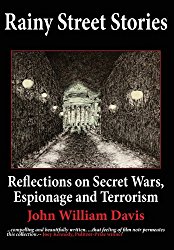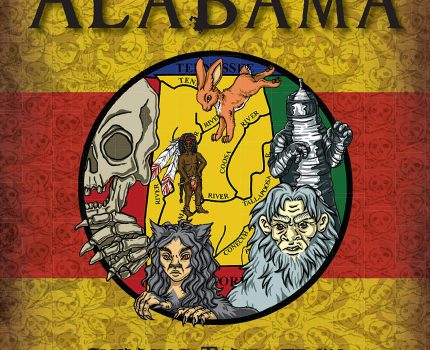Book Review by John Davis
Eerie Alabama, by Alan Brown; History Press: Charleston SC; $21.99 paperback. Book review appeared earlier in the Decatur Daily
Available on Amazon

Wandering off the main highways of Alabama can be pleasurable. Should I not also add mysterious, strange, intriguing and delightful? Yes, all those and more. I would definitely add eerie. Alan Brown, West Alabama University professor and author of numerous works on southern folklore, especially ghost stories, certainly lives up to his claim that Alabama ranks among the eeriest states in the South.
Brown gives us not only the horrific story of the Coosa River monster, a beast of bizarre proportions, but speculation as to what it might have looked like. From monsters to lost treasure, Brown has speculated on the whereabouts of millions in Confederate gold destined for their Army in Tennessee, but buried and never recovered near Athens, Alabama. And let us not forget the missing…those people who just up and walked away, never to be seen again. He offers Ruth Murphree Dorsey, a staid Sunday School teacher. What makes her mysterious tale, and others like it, enjoyable is the speculation. We find that she was reliable, and prompt. What could have caused her to vanish? Brown allows us to consider the facts, and judge for ourselves.
Native American lore can also draw the visitor to famous, and incredibly beautiful, places in Alabama. Noccallula Falls is graced with the statue of a Cherokee maiden, poised to leap into the water below. Her story of a lost love, culminating in suicide, is compelling. Need I add that the location is memorable as well? And what of the grounds upon which the Birmingham Botanical Gardens resides. A cemetery? A forgotten place perhaps better left forgotten? Did you know that Harper Lee, who wrote To Kill a Mockingbird, had collated information about the notorious murder of alleged voodoo Reverend Willie Maxwell? He was a minister who himself stood accused of murder most foul.
One of my favorite stories is about Railroad Bill. The story goes that he was a leader of a band of merry robbers in Alexander City. They robbed trains by the simple expedient of waiting in freight cars, and tossing canned goods out as they left the station. The goods were then retrieved and passed out, Robin Hood style, to locals. How legends are made.
You’ll find these ‘Chilling Tales from the Heart of Dixie‘ memorable, wonderful, and yes, eerie. Brown’s dozens of stories will help you understand how the retelling makes a story into a legend, and the legend into a ‘fact’. Each generation might add something if they travel to ‘where the event happened.’ After all, didn’t you see the face in the Pickens County Courthouse window when you went there? Every part of the state has its tales, and Brown has found lots of them.
~ Book Review by John Davis
Read More from John

John William Davis is a retired US Army counterintelligence officer and linguist. As a linguist, Mr. Davis learned five languages, the better to serve in his counterintelligence jobs during some 14 years overseas. He served in West Germany, Italy, and the Netherlands during the Cold War. There he was active in investigations directed against the Communist espionage services of the Soviet Union and Warsaw Pact. His mission was also to investigate terrorists such as the Red Army Faction in Germany, the Red Brigades in Italy, and the Combatant Communist Cells (in Belgium) among a host of others.
His work during the Cold War and the bitter aftermath led him to write Rainy Street Stories, ‘Reflections on Secret Wars, Terrorism, and Espionage’ . He wanted to talk about not only the events themselves, but also the moral and human aspects of the secret world as well.

And now recently published in 2018, John continued his writing with Around the Corner: Reflections on American Wars, Violence, Terrorism, and Hope.
Two powerful books worth reading.
Read more about them in the following Six Questions:
Six Questions with John Davis: Author of Rainy Street Stories
Six Questions with John Davis: Author of Around the Corner
.
.
.

